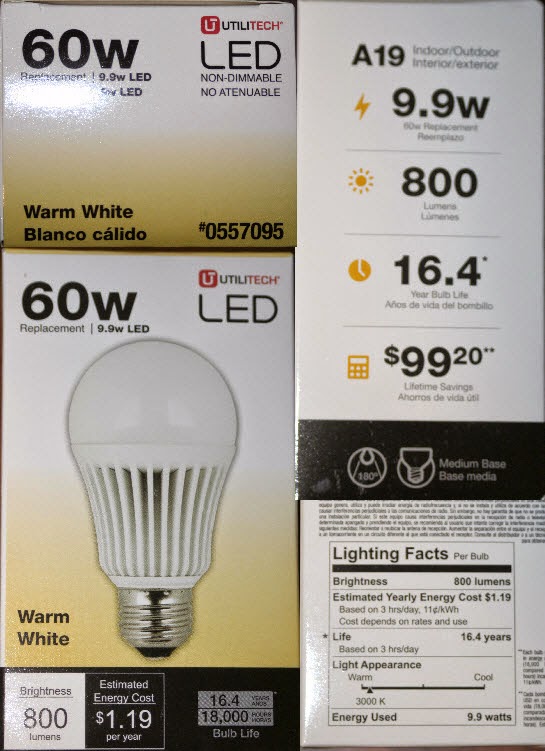Here is my payback math where one would happily use it pointing down, in place of a 100-watt bare bulb in a porcelain fixture. As prescribed on the package, consider operation 3 hours per day and electricity at 11 cents per KWH, for 18,000 hours, 16.4 years. Know though, that electricity cost will more than double over that period. All comparisons using present cost of energy, for something durable, badly misguide a purchase decision.
Over 18,000 hours, the LED bulb will draw 178 KWH, at cost $19.60. Add $6 bulb cost, for a total of $25.60.
Over 18,000 hours with 750 hours life, twenty four 100 watt light bulbs in sequence will draw 1800 KWH, at cost $198. Say your prohibited box of bulbs now expended cost you $24. Your total cost was $222.
You will have had better light, a better life, climbs on a ladder only to paint the ceiling perhaps, and don't drop the bulb. You will have saved $222 - 25.60 = $196. This is about double the Utilitech package claim, because you were smart enough to employ natural LED directionality.
Now, presume you only want to fill that antique bulb fixture, three 60-watt incandescent bulbs pointing to the side and quite obscured by something warm and orangey. You get the same practical illumination as with the single LED bulb unobstructed and pointing down, and you pay three times as much. Over 18,000 hours your cost in the LED adventure will be 3*$25.60 = $76.80, expending 535 KWH.
For the three-bulb fixture comparison, you will have needed a hoard of six dozen bulbs. Hopefully you never had an accident on the ladder. You drew 3240 KWH. Electricity cost somehow frozen in time, you spent $356 on electricity while helping to melt the poles, and you spent about $72 for the bulbs. You will have saved $356 + 72 - 76.80 = $352, at just one of your luminaires. $352 vs. $196, or vs. the box number of $99.20? Don't be silly. That isn't how to make money with LED lighting . Doing something inefficient more efficiently, is still inefficient. Choose directional LED plate lighting, spots of sunshine from your ceiling or beautiful pendant. Let one of your lights be that model airplane landing light beamed at your book. Have some fun. Don't take pride in so-wastefully using period fixtures. Yes, I know some of this is wishful thinking. We will find the future faster if we stop wanting to keep using antique always-inefficient side-directed point-source lamps.
The Utilitech #0557095 seems very directional. The globe glows from the side but with little illumination. Is it this AC LED light engine, from Seoul Semiconductor? A cheap, non-dimmable light engine, would be of an earlier achievement, perhaps this .
One should prefer this directionality. Don't use it then, for side lighting. Beware, this is not warned on the package.
Here is my lighting brightness, comparative task illumination setup at full power. At stage left, Nicor DLS .
At stage right, a 60 watt incandescent (unscrewed), over Utilitech #0557095.
There is a dimmer in the circuit and the Utilitech is loudly buzzing. Dimmed the slightest amount, the Utilitech blinks maddeningly.
The 3000°K Nicor DLS correctly illuminates a white wall. The Utilitech seems to have lower color temperature, perhaps 2800°K, by the uncertain professional discrimination of my Canon Digital Rebel camera, as sensor. Where a 100 watt incandescent bulb is defined B4, the Utilitech is about B4.5.
Learn more about Utilitech LED vs. 60 watt incandescent, by firing the incandescent too.
I think the bulb combination adds up to the same brightness as Nicor DLS, another badly-labeled light, absurdly called 60-watt equivalent
Here again is comparison of Nicor DLS to an old 60 watt incandescent. Anyone must agree the LED plate light is almost three times brighter, and of prettier color..




2 comments:
Hi,
I would like to share review about led bulb product code 0557095.
I think that led bulb is looking very nice and i hope your products specification and other information.
Thanks
Led lights
This link to a bare web site in India is not helpful. Please be helpful, Luxon Light.
I am eager for comments. I challenge so many things in posts like this. If someone disagrees with me, I want to know. If I am helpful, please present details.
Post a Comment